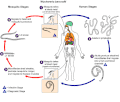Datei:Wuchereria bancrofti LifeCycle.gif
Erscheinungsbild
Wuchereria_bancrofti_LifeCycle.gif (513 × 435 Pixel, Dateigröße: 33 KB, MIME-Typ: image/gif)
Dateiversionen
Klicke auf einen Zeitpunkt, um diese Version zu laden.
| Version vom | Vorschaubild | Maße | Benutzer | Kommentar | |
|---|---|---|---|---|---|
| aktuell | 15:15, 5. Nov. 2008 |  | 513 × 435 (33 KB) | Lycaon | Watermark removed |
| 22:02, 14. Mai 2006 |  | 513 × 435 (36 KB) | Patho | {{Information| |Description=Filariasis [Brugia malayi] [Brugia timori] [Loa loa] [Mansonella ozzardi] [Mansonella perstans] [Mansonella streptocerca] [Onchocerca volvulus] [Wuchereria bancrofti] Life cycle of Wuchereria bancrofti Different species |
Dateiverwendung
Die folgenden 3 Seiten verwenden diese Datei:
Globale Dateiverwendung
Die nachfolgenden anderen Wikis verwenden diese Datei:
- Verwendung auf ceb.wikipedia.org
- Verwendung auf de.wikipedia.org
- Verwendung auf en.wikipedia.org
- Verwendung auf fr.wikipedia.org
- Verwendung auf hu.wikibooks.org
- Verwendung auf nn.wikipedia.org
- Verwendung auf pl.wikipedia.org
- Verwendung auf sv.wikipedia.org


